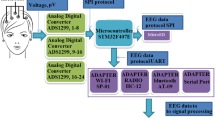Abstract
Use of Electroencephalography (EEG) to detect cognitive load is a well-practiced technique. Cognitive load reflects the mental load imparted on a person providing a crucial parameter for applications like personalized education and usability testing. There are several approaches to process the EEG signals and thus choosing an optimal signal processing chain is not a straight forward job. The scenario becomes even more interesting while using commercial low-cost, low resolution EEG devices connected to cloud through Internet of Things (IoT) platform. This paper proposes an optimized signal processing chain offering maximum classification accuracy and minimum computational complexity for measuring the cognitive load using low resolution EEG devices.
Access this chapter
Tax calculation will be finalised at checkout
Purchases are for personal use only
Similar content being viewed by others
Notes
References
Chen, F., Ruiz, N., Choi, E., Epps, J., Khawaja, M.A., Taib, R., Wang, Y.: Multimodal behavior and interaction as indicators of cognitive load. ACM Trans. Interact. Intell. Syst. (TiiS) 2(4), 22 (2012)
Gubbi, J., et al.: Internet of Things (IoT): a vision, architectural elements, and future directions. Future Gener. Comput. Syst. 29(7), 1645–1660 (2013)
Misra, P., et al.: A computing platform for development and deployment of sensor data based applications and services, Patent No. WO2013072925 A2
Fok, A.W., Ip, H.H.-S.: Personalized education: an exploratory study of learning pedagogies in relation to personalization technologies. In: Liu, W., Shi, Y., Li, Q. (eds.) ICWL 2004. LNCS, vol. 3143, pp. 407–415. Springer, Heidelberg (2004)
Pal, A., Chatterjee, D., kar, D.: Evaluation and Improvements of on-screen keyboard for Television and Set-top Box, ISCE, Singapore, 14–17 June 2011
Hitt, J.M., Kring, J.P., Daskarolise, E., Morris, C., Mouloua, M.: Assessing mental workload with subjective measures: an analytical review of the nasa-tlx index since its inception. Hum. Factors Ergon. Soc. Ann. Meet. 43, 1404 (1999)
Haapalainen, E., et al.: Psycho-physiological measures for assessing cognitive load. In: Proceedings of the 12th ACM Ubicomp (2010)
Molteni, E., et al.: Frontal brain activation during a working memory task: a time-domain fNIRS study. SPIE BiOS: Biomedical Optics. International Society for Optics and Photonics (2009)
Brody, B.A., et al.: The role of frontal and parietal cortex in cognitive processing: tests of spatial and sequence functions. Brain J. Neurology 101(4), 607–633 (1978)
Hjorth, B.: EEG analysis based on time domain properties. Electroencephalogr. Clin. Neurophysiol. 29(3), 306–310 (1970)
Chatterjee, D., Sinharay, A., Konar, A.: EEG-Based fuzzy cognitive load classification during logical analysis of program segments. In: IEEE International Conference on Fuzzy Systems (FUZZ-IEEE), 7–10 July 2013
Zarjam, P., Epps, J., Chen, F.: Evaluation of working memory load using EEG signals In: Proceedings of APSIPA Annual Summit and Conference, pp. 715–719 (2010)
Wang, Y.L., Liu, J.H., Liu, Y.C.: Automatic removal of ocular artifacts from electroencephalogram using Hilbert-Huang transform. In: The 2nd International Conference on Bioinformatics and Biomedical Engineering, 2008. ICBBE 2008, pp. 2138–2141 (2008)
Wojcikiewicz, W., Vidaurre, C., Kawanabe, M.: Stationary common spatial patterns: towards robust classification of non-stationary eeg signals, In: 2011 IEEE International Conference on Acoustics, Speech and Signal Processing (ICASSP), pp. 577–580.(2011)
Lotte, F., Guan, C.: Regularizing common spatial patterns to improve BCI designs: unified theory and new algorithms. IEEE Trans. Biomed. Eng. 58(2), 355–362 (2011)
Sauseng, P., Klimesch, W., Schabus, M., Doppelmayr, M.: Fronto-parietal EEG coherence in theta and upper alpha reflect central executive functions of working memory. Int. J. Psychophysiol. 57(2), 97–103 (2005)
Author information
Authors and Affiliations
Corresponding author
Editor information
Editors and Affiliations
Rights and permissions
Copyright information
© 2015 Institute for Computer Sciences, Social Informatics and Telecommunications Engineering
About this paper
Cite this paper
Sinharay, A., Chatterjee, D., Pal, A. (2015). Cognitive Load Detection on Commercial EEG Devices: An Optimized Signal Processing Chain. In: Giaffreda, R., et al. Internet of Things. User-Centric IoT. IoT360 2014. Lecture Notes of the Institute for Computer Sciences, Social Informatics and Telecommunications Engineering, vol 150. Springer, Cham. https://doi.org/10.1007/978-3-319-19656-5_14
Download citation
DOI: https://doi.org/10.1007/978-3-319-19656-5_14
Published:
Publisher Name: Springer, Cham
Print ISBN: 978-3-319-19655-8
Online ISBN: 978-3-319-19656-5
eBook Packages: Computer ScienceComputer Science (R0)




